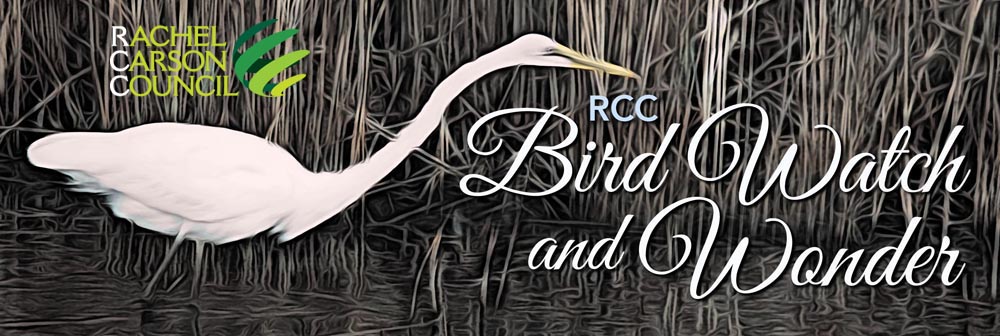 | | | Birds may be feeling scarce this July, but not to worry, they are just trying to escape the heat. In July birds are molting and no longer breeding, so they tend to sing less which is why you might not be hearing your usual bird choruses. Check out the “Bird Lore” section to get tips on how to bird in these conditions! Meanwhile, new advances are being made in bird conservation ranging from stopping pesticide use to birds being reintroduced to their natural habitats to studying bird poop!. 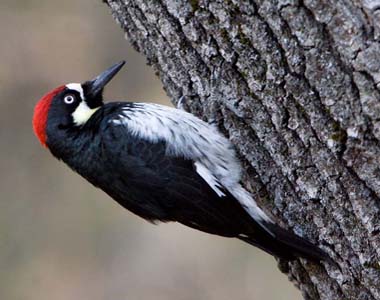 Speaking of amazing birds! All of us have wondered how they do it when even big NFL players can’t. Learn more about how woodpeckers can pound their heads without causing brain damage in our “Bird Findings” section. And you’ll be even more in awe when you read Ross Feldner’s latest lively piece on the even more incredible feats of the indefatigable Acorn Woodpecker. We also profile a more delicate, but feisty little beach bird that deserves a bigger spotlight. This agile, diving beauty also finds ingenious ways to nest and fend of predators at one of Rachel Carson’s favorite spots — Ocracoke on North Carolina’s Outer Banks. The Least Tern is in recovery from nearing extinction in the 20th century and now you can see how. Speaking of amazing birds! All of us have wondered how they do it when even big NFL players can’t. Learn more about how woodpeckers can pound their heads without causing brain damage in our “Bird Findings” section. And you’ll be even more in awe when you read Ross Feldner’s latest lively piece on the even more incredible feats of the indefatigable Acorn Woodpecker. We also profile a more delicate, but feisty little beach bird that deserves a bigger spotlight. This agile, diving beauty also finds ingenious ways to nest and fend of predators at one of Rachel Carson’s favorite spots — Ocracoke on North Carolina’s Outer Banks. The Least Tern is in recovery from nearing extinction in the 20th century and now you can see how. 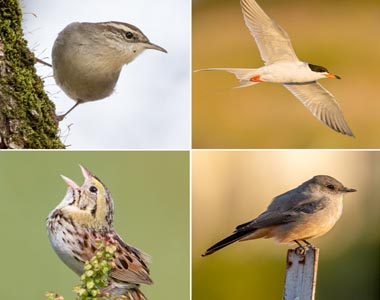 You can also read up on the current controversy over bird names and then weigh in with your views on what birds like Wilson’s Warbler or Say’s Phoebe ought to be called. You’ll find what you need to be heard in “Bird Lore” and “Action and Advocacy.” You can also read up on the current controversy over bird names and then weigh in with your views on what birds like Wilson’s Warbler or Say’s Phoebe ought to be called. You’ll find what you need to be heard in “Bird Lore” and “Action and Advocacy.”
On disturbing bird topics, read about how the historic U. S. Supreme Court ruling in West Virginia v. EPA will affect birds and their habitats. The answer is not pretty. The ruling undermines Federal jurisdiction and will have significant effects on humans and our health, but we also need to acknowledge its terrible impact on our birds and wildlife. But, if you get a chance to relax a bit in July or beat the heat like the birds, we have diverting items for you, too. Under “Books,” check out the review of master birder Scott Weidensaul’s new book if you want to be dazzled by incredible bird migrations and the science behind them. Then take a look at the “Games” section for a quiz to test your knowledge and prepare for your next birding adventure! | | | | | | | | Making the City That Never Sleeps Safer For Birds New York City is at the center of a political fight over dimming nighttime lights that attract and kill migrating birds The spotted bird looked out with big curious eyes, held in the deft hand of wildlife rehabilitator Tristan Higginbotham. It was found days earlier, dazed and unable to fly on the sidewalk in Williamsburg, Brooklyn after smashing into a building. Higginbotham gently released the bird near the floor, and we waited eagerly to see if it would pass the fly test. In a flurry of flapping wings, it took off and settled on a branch near the ceiling. | | | | | | Supreme Court Ruling is Bad News for Birds and Everyone Else, Too The court's ruling in the West Virginia v. Environmental Protection Agency case limits our ability to respond to the climate crisis and could have other serious implications. “This ruling by the Supreme Court directly threatens our ability to protect birds, people, and the places we need,” said Marshall Johnson, chief conservation officer, National Audubon Society. “Birds are telling us that the climate is changing and more action is needed. Stripping agencies like the EPA of their ability to respond to these real and urgent threats puts our communities, birds, and other wildlife at greater risk.” | | | | | | | | | | Help Us Brainstorm New Names for These Six Birds Momentum is building to replace honorific common bird names with more descriptive monikers. Share your ideas here! Bewick’s Wren. Forster’s Tern. Gambel’s Quail. Henslow’s Sparrow. Say’s Phoebe. Wilson’s Phalarope. What do these birds have in common? They’re all named for people—for now. As we explore in a feature story in our Summer issue, there’s growing support in the birding community from hobbyists to professional ornithologists alike to rename these six species and the roughly 145 other birds that bear honorifics. | | | | | | How to Make Bird Feeders With Your Family For fun on the fly, dig through the recycling bin and get ready to spread your creative wings. Great family activity that gets everyone closer to birds. | | | | | | | | Swamps Can Protect Against Climate Change, If We Only Let Them Wetlands absorb carbon dioxide and buffer the excesses of drought and flood, yet we’ve drained much of this land. Can we learn to love our swamps? It can be hell finding one’s way across an extensive boggy moor—the partially dry, rough ground and the absence of any landmarks let the eye rove helplessly into the monotype distance. Everything undulates, the rise and fall share the same muted palette, and the senses dull. But a swamp is different: in it, in addition to water, there are trees and shrubs, just as reeds and rushes are the hallmarks of a marsh. | | | | | | | | | | Old Superfund Law Still Helping Birds When oil kills a pelican, or mercury poisons the eggs of a kingfisher, whose birds have been killed? The answer is that, like the wetlands that nurture our fish, the groundwater that slakes our thirst, the shellfish we eat, and the deer some people like to shoot, birds legally are considered to be yours. Whether the bird is eaten by a hunter, observed by an avid birdwatcher, or listened to by a poet in the park who doesn’t know a pelican from a kingfisher, birds are natural resources that belong to everyone, and their value to society can be translated into dollars. | | | | | | How the Yurok Tribe is Bringing Back the California Condor Birds' reintroduction offered insight into importance of parenting in species. The first California condor to reach Yurok ancestral land in over a century arrived by plane and car in late March of 2022. The small plane that carried Condor 746 had a rough landing, and the bird was irritable. He rattled around in a large dog crate during the three-hour drive to the tribe’s newly built condor facility, in a remote location in Redwood National Park. | | | | | | | | Bird Poop: The Next Frontier of Avian Conservation Far from waste, a splotch of feces contains valuable information about a bird’s diet. Birds, as the saying goes, are what they eat. And knowing exactly what they eat can help conservationists protect critical food sources and track environmental change. But until recently, sussing out birds’ grocery lists was cumbersome, requiring close observation to determine which type of berry a songbird snatched up or what kind of fish dangled from a seabird’s bill. | | | | | | A Study of Published Research Suggests Both Brain Size and Brain-to-Body Ratio Are Factors in Intelligence in Birds An international team of researchers has found evidence that both total brain size and the size of a brain in relation to the body are factors that determine intelligence in animals. In their paper published in the journal Nature Ecology and Evolution, the group describes their study of published papers involving research on intelligence in animals. Prior research and some anecdotal evidence has suggested that brain size plays a major role in how intelligent a creature can be—humans and other primates have very large brains, for example. | | | | | | Why Woodpeckers Don’t Mind Hitting Trees With Their Faces The birds hammer away, yet they don’t get concussed. Scientists found that assumptions about the animals’ impact-absorbing skulls were wrong. Watching a woodpecker repeatedly smash its face into a tree, it’s hard not to wonder how its brain stays intact. For years, the prevailing theory has been that structures in and around a woodpecker’s skull absorb the shocks created during pecking. “Blogs and information panels at zoos all present this as fact — that shock absorption is occurring in woodpeckers,” said Sam Van Wassenbergh, a biologist at the University of Antwerp. | | | | | | | | Acorn Woodpecker a.k.a. The Hoarder HOARDING: the practice of collecting or accumulating something (such as money or food) -Merriam-Webster. The Acorn Woodpecker has one of the more obvious names in the avian world. This striking bird with an almost comical face has a thing for acorns. A group of these birds is called a “bushel,” a perfect description for this Western woodpecker with a most unusual habit. Although they eat insects, sap and fruit, they depend on acorns to a large extent and have a unique solution to maintaining their food source. They store acorns in granaries or “storage trees” by drilling holes and then hammer the acorn into the hole with enough force to knock out us humans. Lots of acorns! | | | | | | Birds of Ocracoke: The Least Tern, Resilient and Feisty I have sometimes mused how I would end my Birds of Ocracoke profile series with: Last, but not least, is the Least Tern. Sometimes called a sea swallow, the Least Tern (Sternula antillarum) has a graceful, fast, buoyant flight pattern with rapid wing beats. Careful observers will notice they are capable of suddenly putting on the skids, hovering above water, then quickly plunging to grab a small fish, their prey of choice. | | | | | | A Duck Needed Help Saving Her Ducklings. A Police Rescue Ensued. A Maryland police officer lowered himself into a storm drain to pick up the ducklings one by one as the mother kept watch. People walk in to police stations for all kinds of reasons — to file a report, to ask an officer a question or maybe to check on a case. At 11 a.m. Wednesday, someone walked into a Montgomery County police station in Olney, Md., with an unusual request for help: A duck was acting strangely by a storm drain. Could the police check it out? The duck, the person said, had been walking on a sidewalk atop the storm drain for about an hour, making a distress noise that sounded like crying. | | | | | | Neonic Nation: Is Widespread Pesticide Use Connected to Grassland Bird Declines? Neonicotinoids are America's most used class of pesticides, found in the vast majority of the nation's corn crop and nearly half of soybeans. Given such pervasive use, their effects on songbirds—impacting critical functions like metabolism, reproduction, and migration—are troubling. Sixty years ago this summer—in June of 1962—the first of a three-part serialization of Rachel Carson’s book Silent Spring was published in The New Yorker. | | | | | | What's In a Bird Name? More than 100 North American birds carry the names of people, some of whom were enslavers, supremacists, or grave robbers. A growing movement aims to do away with honorifics all together and bestow monikers that reflect each species' unique qualities There is something remarkable about looking for birds at last light. When pandemic lockdowns began, I took daily walks around a placid lagoon in a park in downtown Santa Cruz, California. The verdant reeds and towering silver-barked trees glowed in the hours just before sunset. | | | | | | Birdwatching Tips: It’s Summer… Where Did The Birds Go? In the dog days of summer, birds seem to disappear—the dawn chorus wanes and an odd silence takes hold in woodlands. Many birds look bedraggled, no longer sporting their bright breeding colors. A lot of birders hang up their binoculars until fall migration. (July and August are typically the two lowest months for eBird checklist submissions.) But there’s no reason to stop birding. The birds are still there, they’re just keeping a low profile, because they’re replacing their feathers. Knowing what’s going on in the post-breeding lives of birds can help you keep finding species late into the summer. | | | | | | | | A Walking Tour of Manhattan's Audubon Mural Project Two warblers peeped over the scaffolding. Our guide pointed out the vibrant orange coat and black crown of the Blackburnian warbler and the gold neck and white “eyebrows” of the yellow-throated warbler. The warblers weren’t in trees, though. They were in murals. Viewing bird murals in Manhattan is not entirely dissimilar from birding: You never know exactly what you’ll find. A mural could be hidden by scaffolding, or a new one may suddenly appear, or one you expect to see may be gone. | | | | | | Birds of Lake Los Carneros Short Film One of Goleta’s gem locations is the stunning Lake Los Carneros. Now there is a newly released 7-minute short film, Birds of Lake Carneros, shot at this special location available to view. The Santa Barbara Audubon Society (SBAS) and filmmaker Michael Love recently released the short film which is rich in bird conservation, local history, and ecology. The film celebrates local and migrating birds at Lake Los Carneros, raises awareness about the importance of this open space for providing critical habitat to avifauna and other wildlife, and inspires community environmental stewardship and nature conservation. | | | | | | 10 Tips for Capturing Incredible Photos of Birds The most important aspect of capturing sharp, action packed photos of birds actually happens before you leave home, Knoot says. With any form of photography, knowing the ins and outs of the camera is helpful to photographers, but this might be most important for bird photographers. “With bird photography, having the ability to capture an image in the blink of an eye is crucial,” Knoot explains. “You may only have a half a second to capture the perfect shot, so knowing how to make lightning fast adjustments on your camera is a necessity. | | | | | |  | | | A World on the Wing: The Global Odyssey of Migratory Birds
by Scott Weidensaul “Given the state of migratory birds around the world, I needed a little good news.” 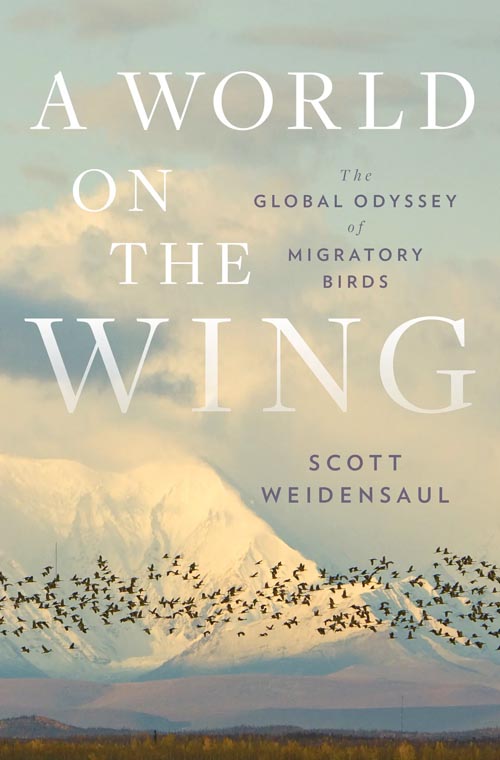 Coming near the end of “A World on the Wing: The Global Odyssey of Migratory Birds” — Scott Weidensaul’s gripping journey alongside the world’s feathered wanderers and the people who study them — these words are necessarily grim. Any longtime birder offers the same lament: Migration just isn’t what it used to be. Coming near the end of “A World on the Wing: The Global Odyssey of Migratory Birds” — Scott Weidensaul’s gripping journey alongside the world’s feathered wanderers and the people who study them — these words are necessarily grim. Any longtime birder offers the same lament: Migration just isn’t what it used to be.
The plummeting numbers of songbirds and shorebirds, raptors and waterfowl, have become painfully apparent; a recent study collating decades of data revealed that nearly a third of all birds — three billion creatures — have vanished from North America in just the last 30 years. Weidensaul tasks himself with communicating to both the knowing birder and the layman the epic scale of what’s happening in our skies every year, the whys and hows, while offering rays of hope through the gloomy storm clouds. The success of “A World on the Wing” in navigating that challenge rivals the astonishing feats of the birds he chronicles.
Those feats and the jaw-dropping science behind them form the heart of the book. A tiny ruby-throated hummingbird crosses the entirety of the Gulf of Mexico in a single nonstop flight; inconceivable, until Weidensaul describes certain whimbrels — a shorebird somewhat bigger than a pigeon — that leave the Canadian Arctic, travel east the width of the continent, and hurl themselves over the North Atlantic, directly into raging seasonal storms whose winds, it turns out, give them a boost for a nonstop transoceanic flight from the Canadian Maritime Provinces to Brazil. Suddenly the hummingbird seems like a slacker. Read more | | | | | | | | 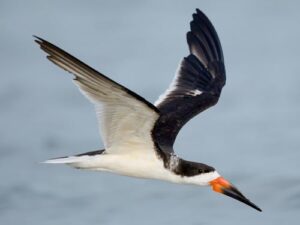 Rachel Carson was an avid birder. Carson even wrote about birds as a child, including a story about Mr. and Mrs. Wren searching for the best nest. Among Rachel’s favorites were the Wood Thrush, also the name of the newsletter of the Audubon Naturalist Society she wrote for while on its Board of Directors. Others included the sanderling, a small sandpiper that dashes along the surf and migrates thousands of miles to the Arctic, and the Black Skimmer, an amazing red-orange scissor-billed shorebird with wide black wings that dramatically appears in the opening of Carson’s very first book Under the Sea-Wind. Rachel Carson was an avid birder. Carson even wrote about birds as a child, including a story about Mr. and Mrs. Wren searching for the best nest. Among Rachel’s favorites were the Wood Thrush, also the name of the newsletter of the Audubon Naturalist Society she wrote for while on its Board of Directors. Others included the sanderling, a small sandpiper that dashes along the surf and migrates thousands of miles to the Arctic, and the Black Skimmer, an amazing red-orange scissor-billed shorebird with wide black wings that dramatically appears in the opening of Carson’s very first book Under the Sea-Wind.
Take the Quiz! | | | | | | The June 2022 issue of Bird Watch and Wonder was produced by RCC Stanback Presidential Fellow Maggie Dees.
 RCC Stanback Presidential Fellow – Maggie Dees RCC Stanback Presidential Fellow – Maggie Dees
Maggie Dees co-leads the RCC Bird Watch and Wonder program. She is a sophomore in the honors program at Virginia Tech University majoring in environmental science. She is from Salisbury, NC, and is passionate about environmental justice and conservation. | | | | | |  The Rachel Carson Council Depends on Tax-deductible Gifts From Concerned Individuals Like You. Please Help If You can. The Rachel Carson Council Depends on Tax-deductible Gifts From Concerned Individuals Like You. Please Help If You can. | | | |  Sign Up Here to Receive the RCC E-News and Other RCC Newsletters, Information and Alerts. Sign Up Here to Receive the RCC E-News and Other RCC Newsletters, Information and Alerts. | | | | | | | | | | | |